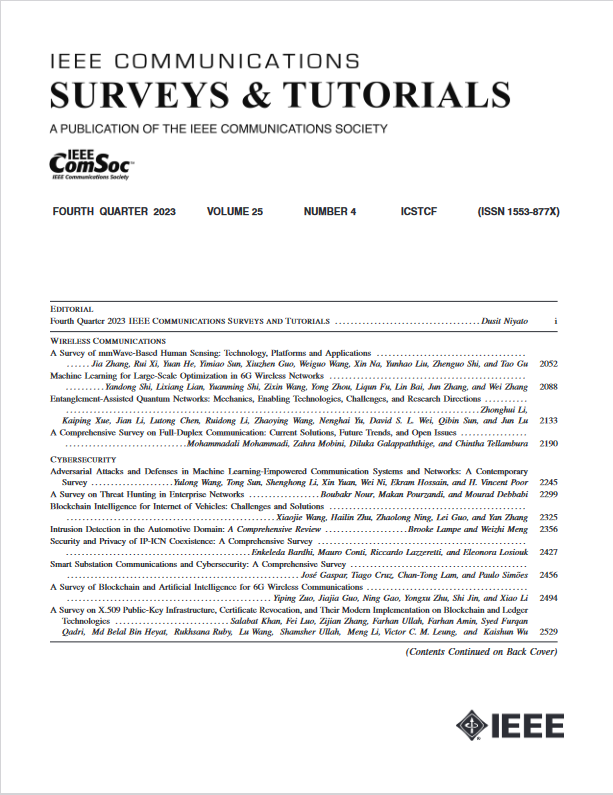低功率GNSS研究进展
IF 34.4
1区 计算机科学
Q1 COMPUTER SCIENCE, INFORMATION SYSTEMS
引用次数: 4
摘要
随着电子设备的小型化,接收器越来越多地嵌入到具有苛刻能量约束的设备中。由于电池供电设备的处理能力有限,以及具有挑战性的无线环境,如城市深处的峡谷、隧道和桥梁、森林树冠、干扰和欺骗的增加,这一过程带来了新的信号处理挑战。后者通常通过新的GNSS星座和GNSS信号的现代化来解决。然而,信号复杂性的增加导致恢复信号的计算要求更高;因此,应该针对每个应用评估精度和能量之间的权衡。本文深入研究了低功耗GNSS,重点研究了电池供电的消费设备和物联网(IoT)传感器中使用的基于卫星的定位接收器的能耗。我们简要概述了全球导航卫星系统的基本知识以及传统信号和现代化信号之间的差异。然后回顾了主导全球导航卫星系统接收器能耗的因素,并特别注意处理算法的复杂性。探讨并比较了机载和卸载(云/边缘)处理策略。最后,我们强调了当今低功耗全球导航卫星系统研究面临的挑战。本文章由计算机程序翻译,如有差异,请以英文原文为准。
A Survey on Low-Power GNSS
With the miniaturization of electronics, receivers are getting more and more embedded into devices with harsh energy constraints. This process has led to new signal processing challenges due to the limited processing power on battery-operated devices and to challenging wireless environments, such as deep urban canyons, tunnels and bridges, forest canopies, increased jamming and spoofing. The latter is typically tackled via new GNSS constellations and modernization of the GNSS signals. However, the increase in signal complexity leads to higher computation requirements to recover the signals; thus, the trade-off between precision and energy should be evaluated for each application. This paper dives into low-power GNSS, focusing on the energy consumption of satellite-based positioning receivers used in battery-operated consumer devices and Internet of Things (IoT) sensors. We briefly overview the GNSS basics and the differences between legacy and modernized signals. Factors dominating the energy consumption of GNSS receivers are then reviewed, with special attention given to the complexity of the processing algorithms. Onboard and offloaded (Cloud/Edge) processing strategies are explored and compared. Finally, we highlight the current challenges of today’s research in low-power GNSS.
求助全文
通过发布文献求助,成功后即可免费获取论文全文。
去求助
来源期刊

IEEE Communications Surveys and Tutorials
COMPUTER SCIENCE, INFORMATION SYSTEMS-TELECOMMUNICATIONS
CiteScore
80.20
自引率
2.50%
发文量
84
审稿时长
6 months
期刊介绍:
IEEE Communications Surveys & Tutorials is an online journal published by the IEEE Communications Society for tutorials and surveys covering all aspects of the communications field. Telecommunications technology is progressing at a rapid pace, and the IEEE Communications Society is committed to providing researchers and other professionals the information and tools to stay abreast. IEEE Communications Surveys and Tutorials focuses on integrating and adding understanding to the existing literature on communications, putting results in context. Whether searching for in-depth information about a familiar area or an introduction into a new area, IEEE Communications Surveys & Tutorials aims to be the premier source of peer-reviewed, comprehensive tutorials and surveys, and pointers to further sources. IEEE Communications Surveys & Tutorials publishes only articles exclusively written for IEEE Communications Surveys & Tutorials and go through a rigorous review process before their publication in the quarterly issues.
A tutorial article in the IEEE Communications Surveys & Tutorials should be designed to help the reader to become familiar with and learn something specific about a chosen topic. In contrast, the term survey, as applied here, is defined to mean a survey of the literature. A survey article in IEEE Communications Surveys & Tutorials should provide a comprehensive review of developments in a selected area, covering its development from its inception to its current state and beyond, and illustrating its development through liberal citations from the literature. Both tutorials and surveys should be tutorial in nature and should be written in a style comprehensible to readers outside the specialty of the article.
 求助内容:
求助内容: 应助结果提醒方式:
应助结果提醒方式:


